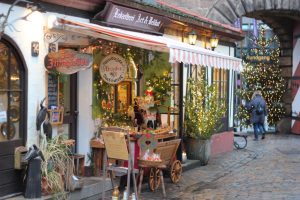
Nuremberg is Bavaria´s second-largest city and located about 160 km north of Munich. The unofficial capital city of Franconia is most famous for its annual Christmas Market (the largest in Europe), the toy fair, the Nuremberg Trials as well as the Nazi Party Rally Grounds. However, Nuremberg´s Old Town can also live up to many tourists’ expectations: a medieval city wall, a hilltop castle and numerous traditional, half-timbered houses. Last but not least, Nuremberg features a few unique culinary delicacies, such as gingerbread, dark beer and, of course, the Nuremberg sausages with sauerkraut.
I had the pleasure of growing up in this city. However, I had not seen the cultural and historical heritage of Nuremberg before starting to work at a local budget hotel. I get asked about recommendations and places to visit on a daily basis and know what it is most tourists come to find in Nuremberg. Honestly, you could easily spend five days in this city, but I assume most of you only have limited time. So I wrote this Nuremberg Budget Travel Guide to give you some suggestions on how to make most of your time in the city while still having an authentic experience.
Day 1: Nuremberg Old Town
On the first day, it´s best to stroll around the historic Old Town with all its medieval alleyways, fountains and churches. While you could take part in an official Walking Tour organized by the city of Nuremberg, I suggest doing it on your own. Just grab a Nuremberg map at the tourist information center at the Main Market Square or inside the Main Railway Station and off you go!
Nuremberg What To Do?
Must-See Sights
Regardless of which option you choose, make sure to include the following sights on your walking tour: the Nuremberg Imperial Castle, the Main Market Square with the Beautiful Fountain, St. Lawrence Church, Weißgerber Gasse (half-timbered houses), Albrecht Dürer House, St. Sebald Chruch, the Hangman´s Bridge and the Craftsmen´s Courtyard.
Optional Sights
Optionally, you may visit the Medieval Dungeons at the Town Hall, the Historic Rock-Cut Cellars, the Nuremberg Imperial Castle Museum, the Way of Human Rights and the Germanisches Nationalmuseum, and the Marriage Merry-Go-Round Fountain.
Suggested Walking Tour
Start your tour at the Central Station and take the Königstraße towards the Old Town. After a good five-minute walk you will reach St. Lawrence Church (Adm: free). This Gothic-style church was built in the 13th century as a three-aisled basilica. Continue on Königstraße and cross the river Pegnitz. From the bridge, you can see the Hospital of the Holy Spirit on the right. Keep to the left until you reach the Main Market Square, where the annual Christmas Market is set up during the Advent season. In summer, the Main Market Square is a perfect location for festivals and open-air concerts as well as weekly markets. If you cross the square, you´ll find the Beautiful Fountain, which is a traditional construction built in the 14th century. While in Nuremberg, you must at least once turn the golden ring on the Beautiful Fountain and make a wish.
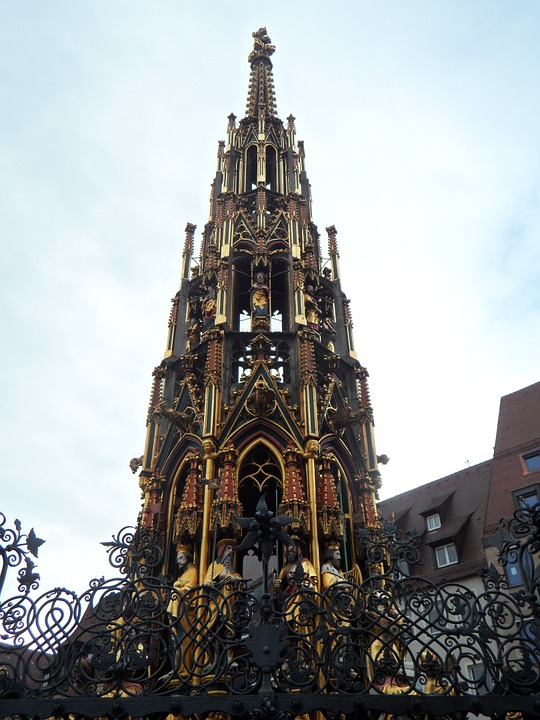
Start walking up the hill towards the castle. You will see “Bratwurst Häusle” on the left. Depending on the time of day and how hungry you are, this may be a good stop to try “3 im Weckla”, 3 Nuremberg sausages in a bun with ketchup or mustard. Keep going, and you´ll soon pass the Town Hall of Nuremberg on the right. There you may also visit the Medieval Dungeons (Adm: 3,50 €), which are found in the cellar vaults of the Town Hall. They served as prisoner cells in the 15th century.
Once reaching the castle, take the stairs to get into the inside of the construction. In addition to being a defensive complex, the Nuremberg Imperial Castle mostly served recreational and research purposes. You can visit the outdoor sites within the castle for free. If you want to gain more detailed information on the historical roles of the Nuremberg Castle, check out the Imperial Castle Museum (Adm: 7,50 €), which presents finds from archaeological digging, ceremonial and tournament armor, crossbows, and firearms. You can learn even more about the historical roles of the castle visiting the Germanisches Nationalmuseum (c.f. below).
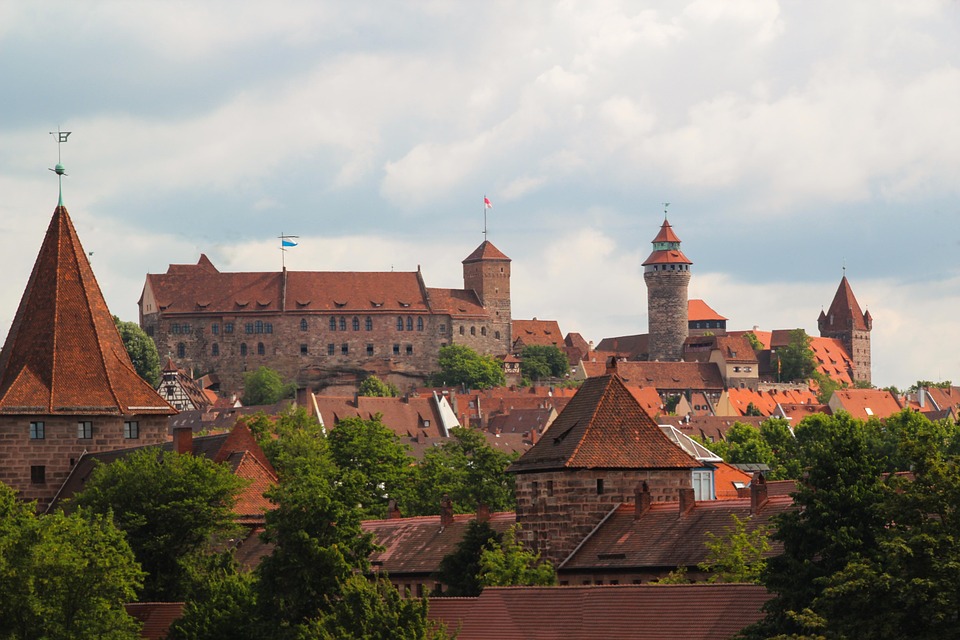
After leaving the castle, turn right on Am Ölberg and walk to the end of the street, where you can turn left. You will reach Tiergärtnertor Square with the famous Albrecht Dürer House (Adm: 5 €). Dürer was a world-famous painter and graphic artist and lived in this half-timbered house in the 16th century. Today, you will find not only reconstructed living areas as well as a large workshop but also a hall with some valuable copies of his paintings.
Take the Bergstraße down towards St. Sebald Church. If you want, you can visit the Historic Rock-Cut-Cellars (Adm: 6 €) on your way, a labyrinth of underground passageways.
St. Sebald Church is the town´s oldest parish church built in Gothic style. It was destroyed during World War II and reconstructed in 1957. With a guide, you can even visit one of the towers, which has an observatory on the top floor from where you have a fantastic view over the whole city of Nuremberg.
From St. Sebald Church, cross Weinmarkt and stroll through Weißgerber Gasse, which has numerous well-preserved half-timbered houses worth taking a picture or two.

At the end of Weißgerber Gasse, cross the street and the small parking lot. You´ll find a chain bridge over the Pegnitz river. On the other side of the river, turn left and follow Untere Kreuz Gasse to the very end, where you´ll find the Hangman´s Bridge -probably my favorite spot in Nuremberg! Situated directly over the river this bridge is a scenic and picturesque place frequented by couples and portrait photographers who seek a romantic, hidden gem. Next to the bridge, there is the Hangman´s Residence Museum (Adm: 2 €), which tells the story of Franz Schmidt, the most famous hangman in the city and how life had been in the early 17th century.
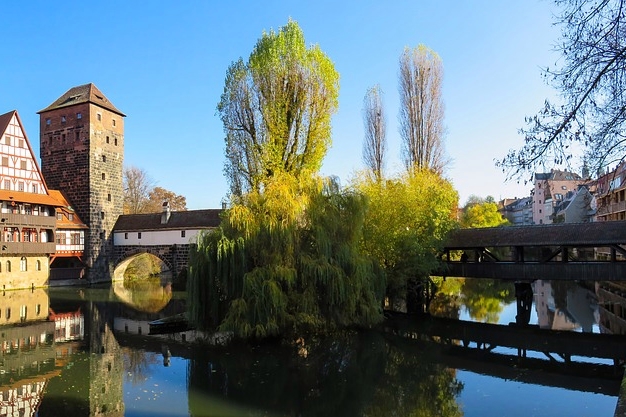
After crossing the Hangman´s Bridge, follow the pedestrian zone. Cross Karlstraße and keep going until you reach Starbucks at Fleischbrücke. Cross the bridge and turn right into Kaiserstraße. At the end of this alleyway, cross the street and take Färberstraße on the opposite side to get to the shopping area. Turn right and follow Karolinenstraße to the Marriage Merry-Go-Round Fountain in front of the White Tower. This fountain relates to the German poem “Bitter-Sweet-Married-Life” and tells the story of a married couple from ardent love to marital fights.
From here, stroll through the other shopping street Breite Gasse. At the second intersection of Breite Gasse, turn right into a small alleyway. Cross Frauengasse and Kornmarkt. Walk through the triumphal arch. You will find yourself in Kartäusergasse aka. The Way of Human Rights with 27 concrete pillars. On each of them, you can read an article of the General Declaration of Human Rights. Also, the main entrance of the Germanisches Nationalmuseum (Adm: 8 €) is located in the middle of this street. This museum is the largest in the German-speaking world and one of the most important in the world. It focuses on cultural history and features numerous world-class pieces of art by Dürer, Rembrandt, and Cranach.
At the end of Kartäusergasse, turn left and walk along the city wall back towards the Main Railway Station. On your way, you will pass the Craftsmen’s Courtyard at Königstor Tower, where you can watch goldsmiths, leather workers, gingerbread makers and other craftsmen perform. They also offer their products for sale. Additionally, the local taverns serve traditional and typical Franconian food and beer.
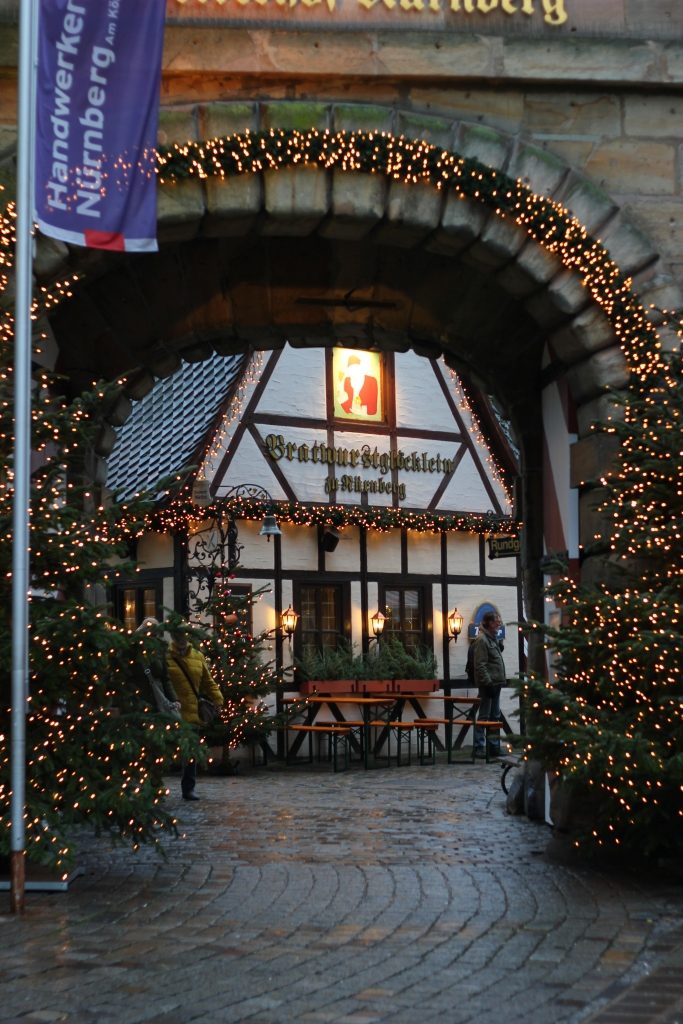
At Night
From the Main Railway Station, take a walk through Königstraße, where you´ll find all kinds of restaurants offering local and international cuisine, such as an Indian restaurant, an American diner, a steakhouse, a Franconian restaurant, etc. If you´re on a budget and up for some more walking, I may recommend the area around Insel Schütt. Cross the square behind St. Lawrence Church, take the stairs down to the river shore and turn right to get to the bridge. Next to this bridge, situated on the island is Bar Celona Finca, a Spanish-influenced bar and restaurant offering international cuisine, tapas and cocktails. It´s not too expensive and one of my favorite places. Alternatively, check out O’sheas on the opposite side of the river, pretty close to the Cinecitta multiplex cinema. O’sheas is the largest Irish pub in Nuremberg and offers some fantastic pub dishes with huge portions.
If you´re still up for one (or multiple) beers after dinner, head back to Königstraße. Unfortunately, over the past decade, Nuremberg has developed into a pretty modern town with luxury bars and a vegan restaurant scene much to my chagrin. The local pub scene that you would expect to find in Franconian beer cities like Nuremberg has waned significantly. For example, in the average bar downtown, you would only find Becks or Jever beers instead of locally brewed beers.
Anyway, to find a budget-friendly and good beer selection in the city center, you have to go to one of the pubs in the area around the Main Railway Station or the castle district. One of my favorites is Mono Bar, a small bar with a great selection of regional beers for very little money. Also, I recommend Hausbrauerei Altstadthof, which is a very traditional brewery at the foot of the Nuremberg Castle.
>> See also: Ultimate Franconia Beer Guide: 14 Unique Beers To Try In Southern Germany
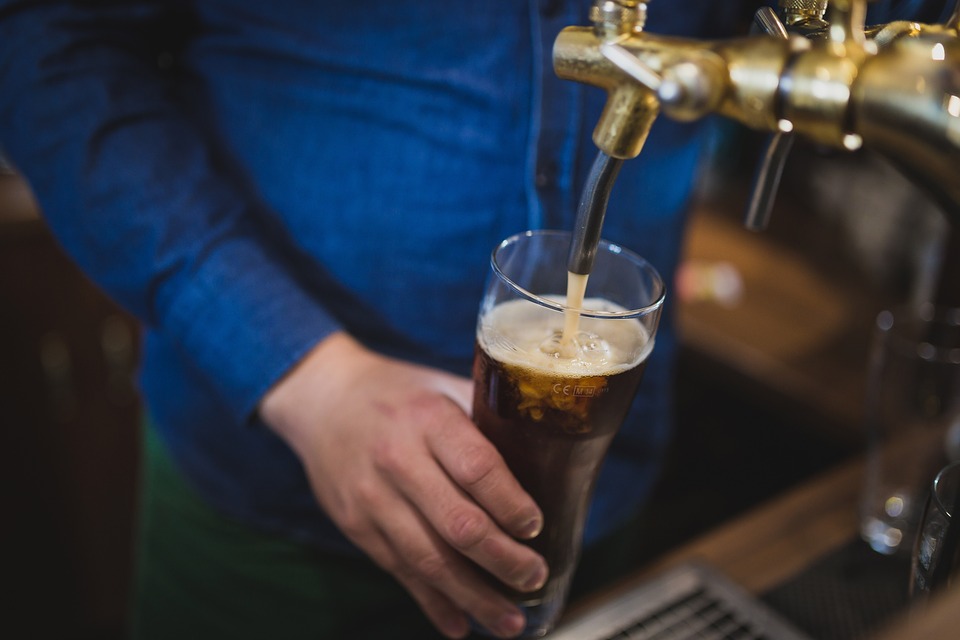
Day 2: Nuremberg´s Recent History
On your second day, dig into the more recent history of Nuremberg by visiting the Documentation Centre Nazi Party Rally Grounds and the Memorium Nuremberg Trials.
Documentation Centre Nazi Party Rally Grounds
First, make your way to the Documentation Centre (Adm: 6 €) next to Dutzendteich Lake (from the Main Railway Station take the tram line 9 to the last stop “Dokuzentrum”).
The permanent exhibition “Fascination and Terror” gives you an in-depth idea of the Nazi regime – from rising to fall. Hand-held audio guides in numerous languages help you understand the causes, contexts, and consequences of the National Socialist tyranny. Also, the museum is pretty visualized with images and video material making it a truly fascinating experience. Visiting the exhibition will take you between 1,5 – 2 hours.
Also, this post explains and sums up the crucial points of Nuremberg’s role during the Third Reich.
The total area covered by the Nazi Party Rally Grounds is approx. 4 km and can still be visited today. Upon leaving the museum, take a map with you of the 23 venues located outside. Look out for large panels providing information on the history of each site. You could easily spend the rest of the day walking around the Dutzendteich Lake (the lake next to the Documentation Centre) as well as Luitpoldain (a large park area) on the other side of the street.
If you are on a limited time schedule, I would suggest only exploring parts of the complex. From the museum, turn right and walk along the lakeshore. You get to see the imposing architecture of the unfinished Congress Hall from the outside. Keep going until you reach the Great Street. Turn left and walk on the Great Street for a while. This street was intended to be the central axis of the grounds. Keep left and continue strolling around the Dutzendteich Lake.
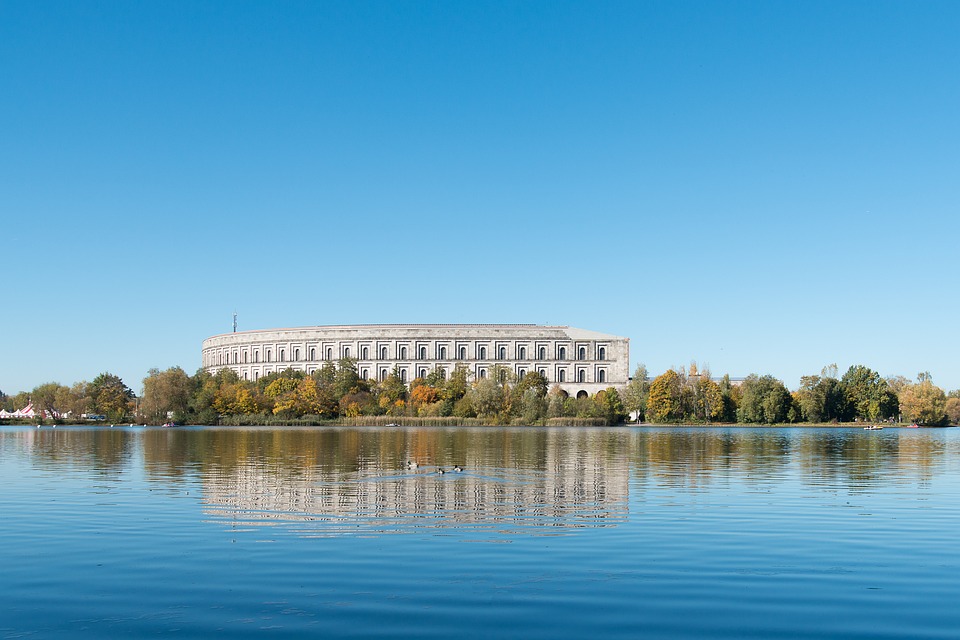
Walking around the lake offers excellent views of the Congress Hall and may be a scenic photography spot. Follow the signs towards Zeppelin Field, which used to be the parade ground where staged propaganda productions were regularly held. In summer, many Nurembergers come here for skating and socializing while sitting on the stairs.
Go back to the lakeshore and keep walking towards the Congress Hall. Right before the main street, there is Gutmann am Dutzendteich, a local restaurant and beer garden on the right. I recommend having some traditional Franconian lunch here as it is less expensive than in the city center and very authentic.
Memorium Nuremberg Trials
If you still have the afternoon, check out the Memorium Nuremberg Trials (Adm: 6 €) inside the Nuremberg Palace of Justice (from the Main Railway Station take the underground line U1 towards Fürth and get off at “Bärenschanze”). That´s the location where the trials against the main war criminals were held from 1945 – 1946. At the original site, you can not only see “Courtroom 600” where the trials took place but also visit an exhibition providing explanations on the role of the defendants in the Nazi regime and the crimes they were accused of. In addition to sound and video footage, there is an audio guide available helping you get a vivid impression of the trials. Visiting the exhibition and courtroom takes around 1,5 – 2 hours.
…Staying More Than 2 Days?
Are you planning on staying in Nuremberg for more than two days? Great! That means you will get to see even more sights. The list of activities and attractions is endless, and you could easily spend an entire week just visiting different galleries or museums.
However, I do have a few preferences and recommendations I´d like to share with you:
Nuremberg serves as headquarters for several internationally-known companies, such as Adidas, Puma or Faber-Castell. While in Nuremberg, you could also take a tour of the premises and visit the outlet shops of each company. Both Adidas and Puma are located in Herzogenaurach. Faber-Castell is situated on the outskirts of Nuremberg.
Otherwise, consider visiting some of the numerous museums, especially if you travel with children, e.g. DB Railway Museum, Communications Museum or Toy Museum.
If you have more time in the area, I also recommend taking day trips to some of these nearby locations, such as the Franconian Switzerland Nature Park or Germany’s beer capital Bamberg with exceptional architecture and breweries.
For more half-timbered houses, historical sites and culinary specialties, check out some of these small German towns off the beaten path or dedicate an entire trip to Germany’s romantic locations with this medieval-themed two-week itinerary.
Also, check if one of these awesome local events is taking place while you’re in town!
Need A Cheap Place To Stay In Nuremberg?
Check out Five Reasons Hotel & Hostel in the Old Town. They offer both affordable private rooms and dorms within walking distance from Nuremberg’s main attractions in the city center.
>> Download my FREE Nuremberg Travel Package! <<
Planning A Trip To Germany?
If you’re looking for travel inspiration, beautiful nature parks, awesome photo spots, fairy-tale castles and medieval towns, these posts have got you covered:
>> Authentic Off-The-Beaten-Path German Towns You Have To Visit
>> Discover Medieval Germany In 14 Days – A Sample Itinerary
>> Ultimate Franconia Beer Guide: 12+ Unique Beers You Have To Try In Southern Germany
For more detailed travel tips, city and castle guides, check out the Germany section and make sure to sign up for e-mail updates to receive a notification once I upload a new post!




5 Responses
Thanks for this post it is really superb and amazing post it is very informative post. They are really nice article shared!